In the documentary series Britain’s Biggest Hoarders we see entire houses taken over by junk – books, souvenirs, toys, clothes are all piled up, making everyday tasks difficult and time-consuming. Things that were useful and valuable in the past, are now impossible to get to, hard to find, or broken.

Inside the home of one of Britain’s biggest hoarders, Mirror.co.uk. Photo © SWNS Group.
If web managers are not careful, digital properties can quickly turn messy too. Web content grows at an astonishing rate. The web has grown by more than one third in 2013 alone, and reached 1 billion websites in 2014.[1] Every minute of every day hundreds of websites are created, 300 hours of video are uploaded to Youtube, nearly 350 tweets are sent and nearly 10,000 images are pinned on Pinterest. [2]
Managing large volumes of content effectively is hard. In fact, even keeping track of what organisations own can be a challenge in some industries. In Digital Clarity Group’s research on Digital Transformation in Higher Education, we interviewed institutions that own more than 1 million webpages over hundreds of websites and domains. Needless to say, manual content audit and quality control of such enormous amounts of information is impossible.
So what do you do with hundreds and thousands of webpages that keep multiplying, because the content management system makes publishing as easy as writing in Word? What do you do with the vast amounts of poor quality content which was created with the help of WYSIWYG but looks more like WYSIWTF?
Almost half of all the higher education organisations that Digital Clarity Group interviewed for the Digital Transformation in Higher Education research, use Siteimprove to regain some degree of control over the content chaos. Siteimprove is a web governance suite of tools which help universities (and other large organisations, for that matter) to find and fix broken links, misspellings, monitor website accessibility and manage SEO.
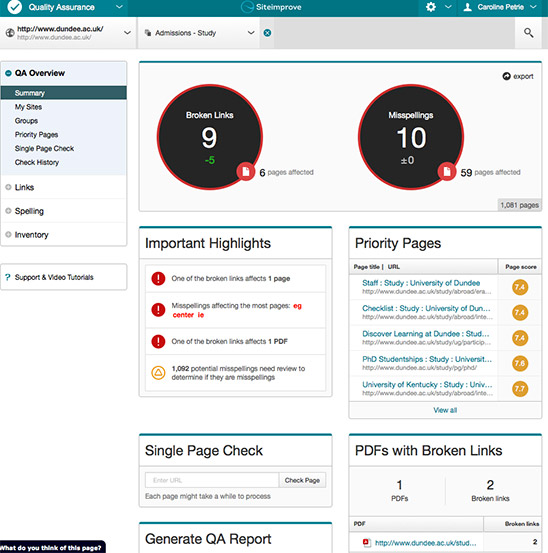
Siteimprove Quality Assurance Overview. University of Dundee.
Siteimprove isn’t the only vendor trying to address the growing issue of content chaos in large organisations. “Web Governance begins where CMS left off”. – says Gavin Colborne, Managing Director of web governance platform LittleForest. “The idea that organisations can manage their websites without any technical knowledge and that it’s a process as easy as using a word processor, is obsolete. Large, global organisations need a set of digital quality standards and best practices that are monitored, with the outcomes measured, on a regular basis. Content management is never a done job.”
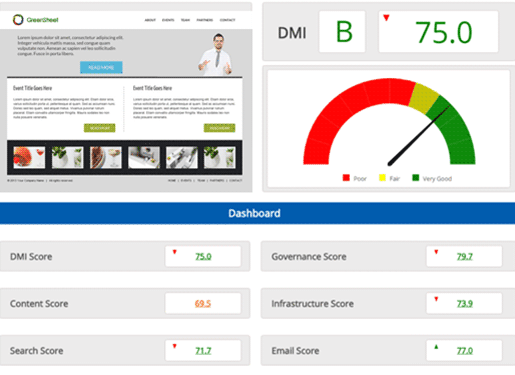
LittleForest Dashboard.
“The key to effective web governance is integration with existing publishing processes and content management systems.” – argues Lawrence Shaw, CEO of Sitemorse. “People don’t want to use another, separate platform, just to check that they’ve done a good job. Time and time again we see organisations approaching web governance in a reactive, firefighting way. Reports on published content are piling up, but once the content is out there, getting content editors to fix the issues is hard. Sitemorse integrates web governance processes into the content management system, so that compliance checks are carried out before the content is published, not after.”
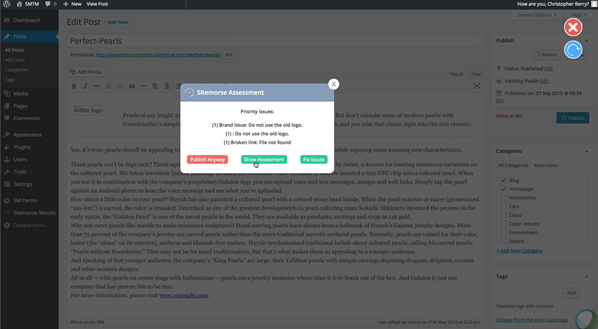
Sitemorse pre-publication checks in WordPress.
The typical checks that web governance tools perform are broken links, spelling mistakes, SEO recommendations and automated web accessibility checks. UK-based software company Silktide, which is about to launch a web governance tool called Insites (currently in beta) tracks interesting new metrics such as mobile site issues, JavaScript errors and social media effectiveness. “We are not reinventing web analytics, like some other vendors. Our focus is on the new types of data and metrics that cannot be captured elsewhere, data that reflects the web governance needs of large, complex organisations today.” – says Oliver Emberton, Founder & Managing Director of Silktide.
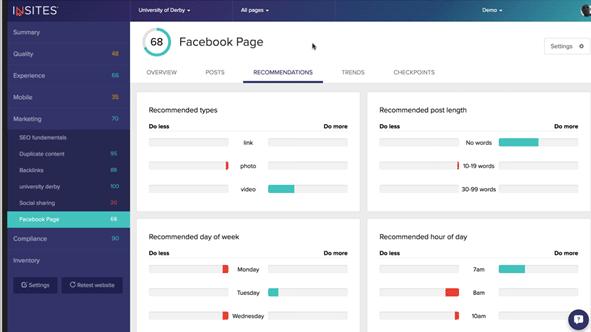
According to the InSites report, the most popular status updates on this university Facebook page are those with ‘no words’ and video content.
Still, with all the data in the world, making changes that really matter isn’t easy. Technology can drive the change, but it’s the people, not just the technology, that ultimately deliver results. You can produce as many digital quality reports as you like, but those reports won’t auto-correct your website, and they will not magically translate into KPIs that make sense for your industry and your organisation. If your digital team has no authority and no influence over people who can implement the changes, then, well… best of luck with your numbers and your technology, but don’t hold your breath. CrownPeak Digital Quality Management (formerly ActiveStandards) was launched in 2005, and identified people challenges in web governance as critically important a long time ago. With Crownpeak Digital Quality Management, you get unlimited support and advisory as part of the package. “We know from experience that one size does not fit all when it comes to digital governance in large, complex organisations.” – says Tom Golden, VP International Sales at Crownpeak.
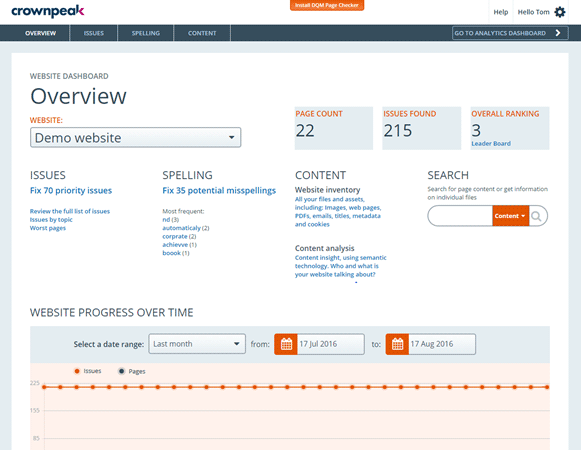
Crownpeak Digital Quality Management (formerly ActiveStandards) dashboard.
Conclusion:
Web content grows at an astonishing rate. Thanks to modern technology, publishing a new webpage, creating a new website, launching a new online community is fast and easy. Or is it?
Predictable but unwanted side effect of decentralised content management practice is the decline in quality of the published digital content. Diluted brand, outdated content, broken links are only a few examples of issues which – if left unresolved – can affect customer experience and cause reputational damage.
The answer to these challenges is Web Governance – a set of rules and practices which allow digital teams to manage websites in a controlled and orderly way. In terms of technology, Web Governance and Digital Quality Assurance is a growing marketplace and is constantly evolving to accommodate modern content types, increasing customer expectations, and new regulatory requirements. Key technology players in this space today are: Crownpeak Digital Quality Management, InSites, LittleForest, Siteimprove and Sitemorse, however effective web governance is as much, if not more, about people and processes, as it is about technology.
